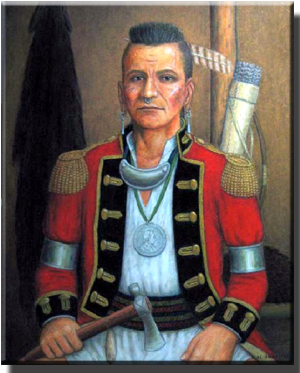Blue Jacket or Weyapiersenwah (c. 1743 – c. 1810) was a war chief of the Shawnee people, known for his militant defense of Shawnee lands in the Ohio. He was noted chiefly as the principal leader of the Indian forces in the battle with General Wayne of August 20, 1794, at Presque Isle, Ohio.
 In the fight with Gen. Harmer in 1790, Bluejacket was associated in command with Little Turtle, but in the battle with General Wayne, Bluejacket assumed command, as Little Turtle was opposed to further warring and urged the acceptance of the offers of peace, but was over ruled by Bluejacket.
In the fight with Gen. Harmer in 1790, Bluejacket was associated in command with Little Turtle, but in the battle with General Wayne, Bluejacket assumed command, as Little Turtle was opposed to further warring and urged the acceptance of the offers of peace, but was over ruled by Bluejacket.
After the defeat of the Indians, Bluejacket was present at the conference at Greenville, Ohio, and signed the treaty of 1795 made with Wayne at that place. He also signed the treaty of Ft Industry, Ohio, July 4, 1805.
It is probable that he died soon after this date, as there is no further notice of him. Later descendants of the same name continued to be influential leaders in the tribe in the west.
The Shawnee Bluejacket family reaches back into the mid-1700s. Records begin with Chief Bluejacket himself, also known by his Native names of Se-pet-te-he-nath, Big Rabbit, his name given at birth and Wa Weyapiersehnwaw, his adult chosen name, meaning Whirlwind, found in use about 1777.
Little is known of Blue Jacket’s early life. He first appears in written historical records in 1773, when he was already a grown man and a war chief. In that year, a British missionary visited the Shawnee villages on the Scioto River and recorded the location of Blue Jacket’s Town on Deer Creek (present Ross County, Ohio).
This would put BlueJacket’s birth at least before 1750. Historians estimate it to be about 1743.
Blue Jacket participated in Dunmore’s War and the American Revolutionary War (allied with the British), always attempting to maintain Shawnee land rights. With the British defeat in the American Revolutionary War, the Shawnee lost valuable assistance in defending the Ohio Country. The struggle continued as white settlement in Ohio escalated, and Blue Jacket was a prominent leader of the resistance.
On November 3, 1791, the army of a confederation of Indian tribes, led by Blue Jacket and Miami Chief Little Turtle, defeated an American expedition led by Arthur St. Clair, governor of the Northwest Territory. The engagement, known as the Battle of the Wabash or as St. Clair’s Defeat, was the crowning achievement of Blue Jacket’s military career, and the most severe defeat ever inflicted upon the United States by Native Americans.
Blue Jacket’s triumph was short-lived. The Americans were alarmed by St. Clair’s disaster and raised a new professional army, commanded by General Anthony Wayne. On August 20, 1794, Blue Jacket’s confederate army clashed with Wayne at the Battle of Fallen Timbers, just south of present-day Toledo, Ohio. Blue Jacket’s army was defeated, and he was compelled to sign the Treaty of Greenville on August 3, 1795, ceding much of present-day Ohio to the United States.
In 1805, Blue Jacket also signed the Treaty of Fort Industry, relinquishing even more of Ohio. In Blue Jacket’s final years, he saw the rise to prominence of Tecumseh, who would take up the banner and make the final attempts to reclaim Shawnee lands in the Ohio Country.
Later a story spread that he was in fact a European settler named Marmaduke Van Swearingen, who had been captured and adopted by Shawnees in the 1770s, around the time of the American Revolutionary War. This story, popularized in historical novels written by Allan W. Eckert in the late 1960s, remains well known in Ohio, where an outdoor drama celebrating the life of the white Indian chief was performed yearly in Xenia, Ohio from 1981 until 2007.
However, subsequent DNA testing proved that story to be false. Bluejacket’s DNA is unquestionably Native, and the Swearingen family’s is not. Not only does the Bluejacket and Swearingen DNA not match, they are not even in the same haplogroup. Swearingen is European, so they haven’t shared a common ancestors in 10s of thousands of years.
Off Site Related Links:
An article published in the Ohio Journal of Science in September 2006 which details the DNA findings comparing males from the Blue Jacket Family and males from the Swearingen family.
The Bluejacket family website with further information about history and current activities.
On this site is the list of the 772 Shawnee adopted into the Cherokee tribe in 1871.